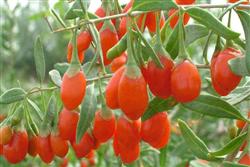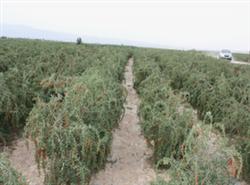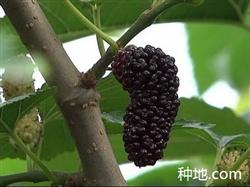High yield and high quality cultivation of Lycium barbarum

Lycium barbarum is a deciduous shrub of the genus Lycium barbarum of Solanaceae. Its leaves, fruit roots and bark all have extensive medicinal value. It is not only suitable for drought, sand wasteland, saline-alkali land planting, but also an excellent tree species in courtyard economy; the fruiting period is long, it can be planted for 50 years in the same year, and it can enter the full fruit period in 3-4 years. Generally, the yield of dried fruit can reach more than 3000 kg per hectare, and its fruit contains a variety of organic compounds and nutrients, which can tonify the kidney, nourish the liver, clear eyes, promote blood circulation, anticancer and so on. Improved varieties were selected for ①. There are many varieties of Chinese wolfberry, including nearly 10 kinds of wolfberry alone. In order to achieve high quality and high yield, seed selection should be done well. In the first and middle of the month, on the plants of hemp leaves or hemp leaves with green leaves, short internodes of fruit branches, stout, few thorns, robust growth and no disease and insect pests, the mature fruits with large grains, bright red fruit color and high sugar content were selected for seed use. Crumple the fruit after harvest, rinse with clean water, rinse the peel and flesh, filter out the juice, rinse the seeds, and dry them in a dry and ventilated place. On the plant of this variety, the branches with short internodes, positive color, strong growth, full bud eyes and disease-free insects can also be cut into 20 cm long for cutting seedlings. The roots and tillers can also be dug up and planted directly under the trees of excellent varieties. Strong seedlings were cultivated by ②. Choose fertile sandy loam soil as nursery, apply 60 ~ 75,000 kg organic fertilizer per hectare and irrigate well. The area of the small bed is 10-20 m 2. It was sown in the flat bed in April, and the sowing rate was 1500-2250 g. Border surface open 4 cm wide ditch, ditch depth 1 cm, seeds and 10 times fine sand mixed well into the ditch, covered with fine wet soil 0.5 cm, firm, and then covered with wet broken grass to prevent moisture loss. The row spacing is 10 cm × 40 cm, and there are more than 225000 seedlings per hectare. We will strengthen the management of water and fertilizer, loosen the soil, weed and fix seedlings. When the seedlings grow to 60 centimeters high, wipe out all the buds below 50 centimeters, and when the growth height reaches 75 centimeters, coring and shaping, strong seedlings can be cultivated. ③ reasonable close planting. From late March to early April, the planting method of furrow irrigation on both sides of ridge planting was adopted, with a row spacing of 1.5m × 2m, planting about 3300 plants per hectare, digging a pit of 40cm × 40cm × 40cm, applying mature farm manure 2cm thick and mixed with mature soil, covering the fertilizer with fine mature soil of 10cm, and then planting the erect and robust Lycium barbarum seedlings with 3 or 5 fibrous roots in the pit, covering the soil, stepping, and watering in time. To improve the survival rate. ④ ploughing and weeding. Spring turn and autumn turn are carried out in April and September every year, with a depth of 20 cm. Four or six times of intertillage and weeding were carried out from May to July, with a depth of 6cm. It is helpful to eliminate diseases, pests and weeds, loosen the soil and ensure the normal growth and development of Lycium barbarum. Except for the intercropping of melons, sugar beets or dwarf crops planted in the garden, intercropping of other crops is strictly prohibited in the future. ⑤ fertilizer and water management. The fruit of Chinese wolfberry is divided into summer fruit and autumn fruit, so fertilizer and water have great influence on the yield and quality of Chinese wolfberry. The annual fertilizer application amount of Chinese wolfberry for more than three years (full fruit period) per hectare (8-9 times) must ensure 350kg of urea, 3000 kg of diammonium phosphate or triplet superphosphate, and more than 37000 kg of high-quality barnyard manure. According to the sprouting, flowering and fruit expansion, the basal fertilizer was applied once in autumn. According to the age of the tree, dig a pit or a circular trench 20 to 60 centimeters from the trunk, 20 to 30 centimeters deep, apply fertilizer into the pit or ditch, cover the soil, and irrigate in time. In addition to deep fertilization on the ground, foliar fertilizer spraying also played a significant role in increasing the 1000-grain weight of fruit. It was sprayed 4 times in the first fruit period from June to July and twice in the second fruit period from August to September. Each time, 750-1500 grams of potassium dihydrogen phosphate per hectare, 750 grams of urea, 750 kilograms of water, 15 leaf noodles per hectare (5 milliliters) plus not 750 kilograms per hectare. In addition to timely irrigation after topdressing and irrigation required after each fruit picking, water is generally irrigated once every 12 days, once every 7 days, each time about 600m 900m 3, so that the summer water can be fully irrigated and the winter water should be well irrigated. ⑥ plastic surgery and pruning. The shaping, pruning and coring of Chinese wolfberry play an important role in regulating reproductive growth and vegetative growth. The fruiting ability of the fruiting branches of the same year and biennial is the strongest, and the perennial and biennial spring branches are the best. Mastering the habits of these results plays an important guiding role in reasonable pruning. Pruning principle: pruning includes two parts: shaping and pruning. Reasonable pruning can effectively improve the ventilation and light transmission conditions inside the crown, which plays an important role in accelerating the formation and expansion of the crown and balancing the tree potential. Make the tree grow strong, enhance the resistance, increase the fruiting branches, make the new shoots flourish, prevent overgrowth and premature senescence, adjust the relationship between growth and fruit, and promote flower bud differentiation. As a result, the young trees can bear fruit early and have high yield, make the adult trees have high and stable yield, prolong the full fruit period and improve the fruit quality. The tree shape of Lycium barbarum after shaping can be divided into evacuation layered shape, natural happy shape, natural cluster shape and so on. For Chinese wolfberry with different tree shapes and different growth years of the same tree shape, the requirements for pruning are also different. But in any case, in the year after planting, it is necessary to make reasonable shaping according to the idea of tree shape, so that the trunk, main branches, lateral branches and branchlets are clearly defined. A Chinese wolfberry can be roughly divided into 5 layers, each layer spacing 25 cm, the tree body is semicircular, the tree height is about 1.6 meters, the crown is about 1.5 meters. It is required to cultivate more fruiting branches, cut off non-productive branches, and master the pruning principle of "three go and three stay", that is, to get rid of the old and stay new, get sick and stay strong, and make the fruit branches evenly distributed in the crown. Operation process: in the same year after planting, reasonable shaping should be carried out according to the growth of the seedlings. Three tree trimming methods. Evacuation stratification: the fixed stem is about 50 cm high and has a central trunk, wiping out all the budding buds or branches below 20 cm at the top. At the top 20 cm, three main branches were selected, each with a distance of about 10 cm, as the first layer, 2-3 lateral branches were left on each main branch, and 2-3 main branches were left on the trunk next year as the second layer, and 2-3 lateral branches were also left on the branches, and so on. The lateral branch of the uppermost main branch can be reduced by one. The height of the tree is about 1.6 meters, and the crown diameter is about 1.5 meters. Sturdy, carrying a large amount of fruit. Natural happy shape: the height of the fixed stem is 20 cm, there is no obvious central trunk, and 3 main branches are selected at the base of the stem, each with an angle of about 30 °. There are 2-3 staggered lateral branches on each main branch, and the lateral branches are about 30 cm apart. Several oblique branchlets are selected on the main side branches, and the tree shape can be formed in 2 to 3 years. The tree has the advantages of good ventilation and light transmission, early fruit, high yield and good quality. This kind of shaping method is easy, the pruning quantity is small, and the management is convenient. Natural clump shape: without center trunk, 3-4 main branches grow directly from the ground, each main branch alternately matches 3-4 side branches, except the first side branch is 40-50 cm away from the base of the main branch, the other side branches are about 30 cm apart, and the fruiting branchlets are selected on the main side branches. the tree shape is well ventilated and transparent, which is beneficial to make full use of the space to achieve three-dimensional results. Pruning and plastic surgery are inseparable. Pruning is divided into autumn pruning, spring shearing and summer shearing. The requirements for pruning of Lycium chinense after one year, two years and three years are different, which should be strictly grasped. Autumn pruning: the time is from mid-October to mid-November, according to the requirements of three to three stay, cut off the non-productive branches and renew the fruit branches. In this way, the nutrient reserve of the plant can be increased and the fruit yield next year can be increased. Spring pruning: the time is from late March to early April, mainly to make up for the lack of last autumn pruning, cut the dry and prickly branches in winter, and sparse the dense branches to further improve the light conditions inside the crown. For biennial Lycium barbarum, when pruning annual branches in spring, the length of the main branch is 30cm ~ 40cm, the length of the lateral branch is about 20cm, and the length of the branchlet with gaps on the main and lateral branches is 8cm ~ 10cm. The key to the fruiting rate of the branches with large gaps is mainly to select biennial branches. The length of the main and lateral branches is 40cm and 50cm, and the length of branchlets is 20cm and 30cm. A twig was left on the lateral branch every 15 cm or so, and the fruiting branch group was cultured. By pruning the plant, the crown has been shaped. Summer pruning: the time is from June to August, mainly cutting off the sprouts, tillers and overgrown branches of the cut, saw, main branch, trunk and root, so as to reduce nutrition consumption. However, attention should be paid to retaining the auxiliary fruit branches used for supplementary space as the main branches. When the newly planted Chinese wolfberry sends out secondary branches, and the new branches of the old Chinese wolfberry grow to 40-60 cm, or when the branches grow to 20-30 cm in the crown space, they should pick out the heart and cut the shoots in time; wipe buds and remove sprouting in advance to the surrounding branches, so as to concentrate nutrients and promote flowering inside and outside the crown to bear three-dimensional fruit. It also promotes the middle and lower parts of these branches to send out more new branches and cultivate more fruiting branches, which has an obvious effect on increasing the yield of Lycium barbarum in the same year. It has a good effect on prolonging the fruiting life of Chinese wolfberry. Prevention and control of ⑦ diseases, pests and birds. Chinese wolfberry diseases include blight, anthracnose, root rot, black rot, mildew, gum disease and so on. Pests are negative mud insects, gall mites, jumping beetles, wood lice, aphids, red spiders and so on. Harmful birds include blackbirds, sparrows and so on. The main measures are to strengthen the management of the garden field to promote the growth of the tree potential, to strengthen the care when the fruit is ripe, to clean the garden field and to protect and utilize the natural enemies. In case of serious occurrence of diseases and insect pests, pesticides with high efficiency, low toxicity and low residue can be selected, such as acark, omethoate, dichlorvos, Dysen zinc, Bordeaux solution and so on. ⑧ harvesting processing. Harvest should be ripe and harvested at any time, pick and place lightly, touch less branches, and avoid fruit falling to the ground. The basket of Chinese wolfberry can only be filled with 20-30 cm thick, can not be squeezed, and washed in time with 3%-4% sodium carbonate aqueous solution. Soak the Chinese wolfberry fruit and spread it into a bamboo curtain with a width of 1.2 meters and a length of 2 meters, with a thickness of 1.5 cm and 2 cm. Pay attention to do not turn at this time, when it rains, it should be covered with plastic sheeting to prevent rain from falling on the fruit of Chinese wolfberry until it is dried in the sun to improve the value of the goods. After the Chinese wolfberry fruit is sun-dried, the impurities are removed and then graded and packaged.
- Prev

Control of black fruit disease of Lycium barbarum
The occurrence of Chinese wolfberry root rot is common and the harm is serious. 3% of the plants die due to the disease every year, which causes great losses to the production of Chinese wolfberry. According to the research of Lu Zhankui and others of Ningxia Academy of Agriculture and Forestry, there are two types of root rot symptoms: (1) root rot type. The root or root neck decayed and peeled off to varying degrees, and the stem.
- Next

What should be paid attention to in fruit mulberry planting?
Prepare to plant fruit mulberry, what should be paid attention to in fruit mulberry planting? The row spacing of general fruit mulberry garden is 1.0m × 2.0m, and that of rapid dense planting garden or greenhouse is 0.4m × 0.6m × 1.3m 1.5m. Shanguo 408, Xinhongbao or Shaansang 404 with upright branches and compact tree shape should be planted with higher planting density; the branches are oblique and open.
Related
- Fuxing push coffee new agricultural production and marketing class: lack of small-scale processing plants
- Jujube rice field leisure farm deep ploughing Yilan for five years to create a space for organic food and play
- Nongyu Farm-A trial of organic papaya for brave women with advanced technology
- Four points for attention in the prevention and control of diseases and insect pests of edible fungi
- How to add nutrient solution to Edible Fungi
- Is there any good way to control edible fungus mites?
- Open Inoculation Technology of Edible Fungi
- Is there any clever way to use fertilizer for edible fungus in winter?
- What agents are used to kill the pathogens of edible fungi in the mushroom shed?
- Rapid drying of Edible Fungi

